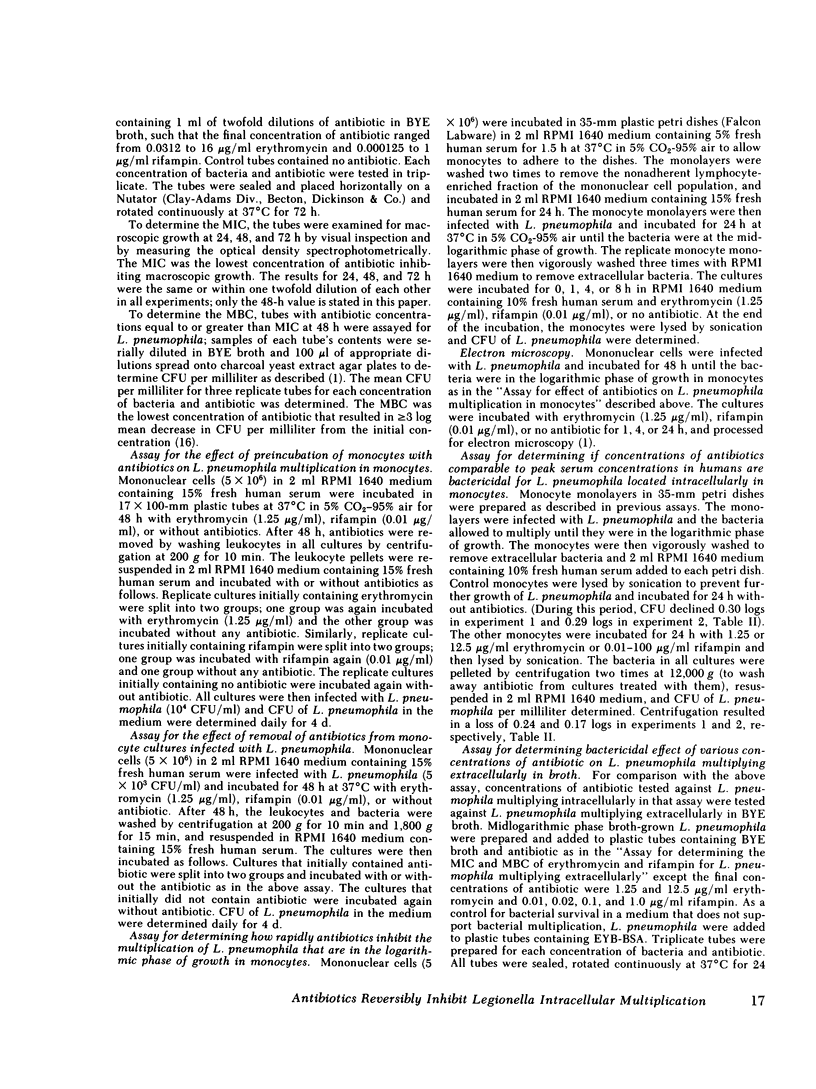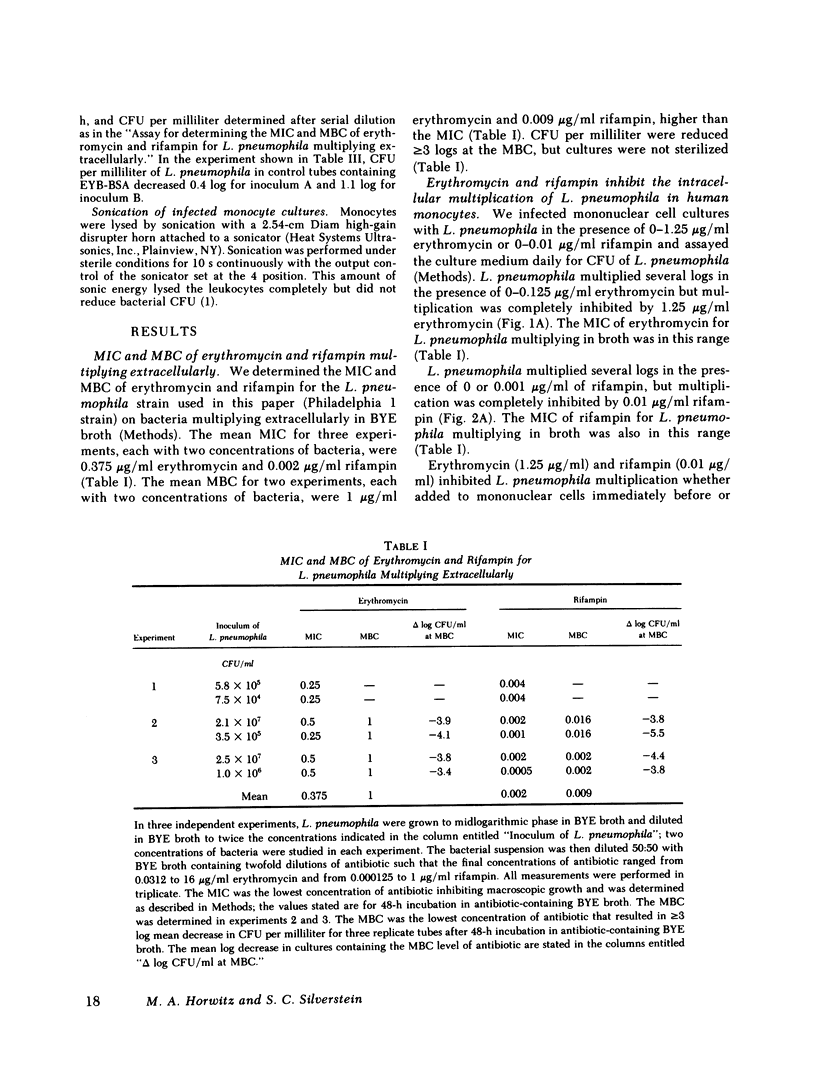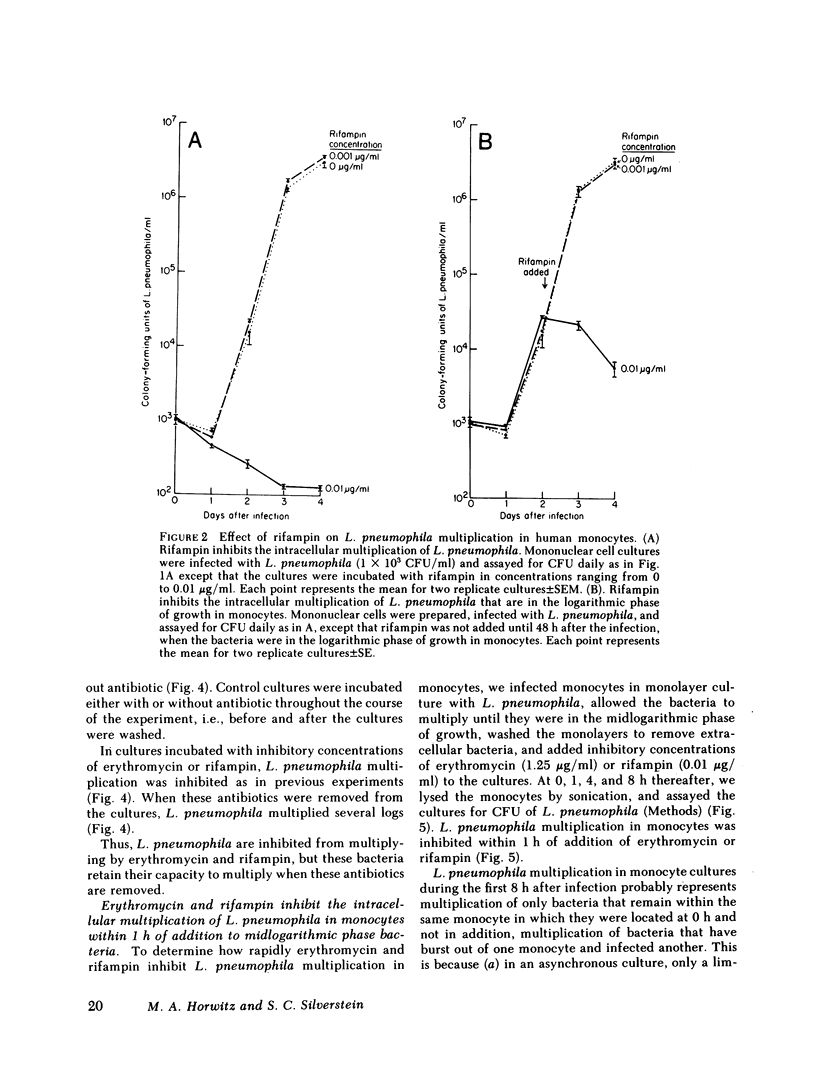Abstract
We have previously reported that virulent egg yolk-grown Legionella pneumophila, Philadelphia 1 strain, multiplies intracellularly in human blood monocytes and only intracellularly under tissue culture conditions. In this paper, we have investigated the effect of erythromycin and rifampin on L. pneumophila-monocyte interaction in vitro; erythromycin and rifampin are currently the drugs of choice for the treatment of Legionnaires' disease. The intracellular multiplication of L. pneumophila is inhibited by erythromycin and rifampin, as measured by colony-forming units, whether the antibiotics are added just before or just after infection of monocytes with L. pneumophila, or 2 d after infection when L. pneumophila is in the logarithmic phase of growth in monocytes. Intracellular multiplication of L. pneumophila is inhibited by 1.25 microgram/ml but not less than or equal to 0.125 microgram/ml erythromycin and 0.01 microgram/ml but not less than or equal to 0.001 microgram/ml rifampin. These concentrations of antibiotics are comparable to those that inhibit extracellular multiplication of L. pneumophila under cell-free conditions in artificial medium; the minimal inhibitory concentration is 0.37 microgram/ml for erythromycin and 0.002 microgram/ml for rifampin. Multiplication of L. pneumophila in the logarithmic phase of growth in monocytes is inhibited within 1 h of the addition of antibiotics. Intracellular bacteria inhibited from multiplying by antibiotics are not killed. By electron microscopy, the bacteria appear intact within membrane-bound vacuoles, studded with ribosomelike structures. L. pneumophila multiplying extracellularly on artificial medium is killed readily by relatively low concentrations of erythromycin and rifampin; the minimal bactericidal concentration is 1 microgram/ml for erythromycin and 0.009 microgram/ml for rifampin. In contrast, L. pneumophila multiplying intracellularly is resistant to killing by these concentrations of erythromycin and rifampin or by concentrations equal to or greater than peak serum levels in humans. Extracellular L. pneumophila in stationary phase is also resistant to killing by erythromycin and rifampin. These findings, taken together with our previous work, indicate that, in vivo, L. pneumophila is resistant to killing by erythromycin and rifampin. Inhibition of L. pneumophila multiplication in monocytes by antibiotics is reversible; when the antibiotics are removed from infected monocyte cultures after 2 d, L. pneumophila resumes multiplication. This study indicates that patients with Legionnaires' disease under treatment with erythromycin and rifampin require host defenses to eliminate L. pneumophila, and that inadequate host defenses may result in relapse after cessation of therapy.
Full text
PDF











Selected References
These references are in PubMed. This may not be the complete list of references from this article.
- Fraser D. W., Tsai T. R., Orenstein W., Parkin W. E., Beecham H. J., Sharrar R. G., Harris J., Mallison G. F., Martin S. M., McDade J. E. Legionnaires' disease: description of an epidemic of pneumonia. N Engl J Med. 1977 Dec 1;297(22):1189–1197. doi: 10.1056/NEJM197712012972201. [DOI] [PubMed] [Google Scholar]
- Fraser D. W., Wachsmuth I., Bopp C., Feeley J. C., Tsai T. F. Antibiotic treatment of guinea-pigs infected with agent of Legionnaires' disease. Lancet. 1978 Jan 28;1(8057):175–178. doi: 10.1016/s0140-6736(78)90611-6. [DOI] [PubMed] [Google Scholar]
- Horwitz M. A., Silverstein S. C. Activated human monocytes inhibit the intracellular multiplication of Legionnaires' disease bacteria. J Exp Med. 1981 Nov 1;154(5):1618–1635. doi: 10.1084/jem.154.5.1618. [DOI] [PMC free article] [PubMed] [Google Scholar]
- Horwitz M. A., Silverstein S. C. Influence of the Escherichia coli capsule on complement fixation and on phagocytosis and killing by human phagocytes. J Clin Invest. 1980 Jan;65(1):82–94. doi: 10.1172/JCI109663. [DOI] [PMC free article] [PubMed] [Google Scholar]
- Horwitz M. A., Silverstein S. C. Interaction of the Legionnaires' disease bacterium (Legionella pneumophila) with human phagocytes. I. L. pneumophila resists killing by polymorphonuclear leukocytes, antibody, and complement. J Exp Med. 1981 Feb 1;153(2):386–397. doi: 10.1084/jem.153.2.386. [DOI] [PMC free article] [PubMed] [Google Scholar]
- Horwitz M. A., Silverstein S. C. Interaction of the legionnaires' disease bacterium (Legionella pneumophila) with human phagocytes. II. Antibody promotes binding of L. pneumophila to monocytes but does not inhibit intracellular multiplication. J Exp Med. 1981 Feb 1;153(2):398–406. doi: 10.1084/jem.153.2.398. [DOI] [PMC free article] [PubMed] [Google Scholar]
- Horwitz M. A., Silverstein S. C. Legionnaires' disease bacterium (Legionella pneumophila) multiples intracellularly in human monocytes. J Clin Invest. 1980 Sep;66(3):441–450. doi: 10.1172/JCI109874. [DOI] [PMC free article] [PubMed] [Google Scholar]
- Johnson J. D., Hand W. L., Francis J. B., King-Thompson N., Corwin R. W. Antibiotic uptake by alveolar macrophages. J Lab Clin Med. 1980 Mar;95(3):429–439. [PubMed] [Google Scholar]
- Lewis V. J., Thacker W. L., Shepard C. C., McDade J. E. In vivo susceptibility of the Legionnaires disease bacterium to ten antimicrobial agents. Antimicrob Agents Chemother. 1978 Mar;13(3):419–422. doi: 10.1128/aac.13.3.419. [DOI] [PMC free article] [PubMed] [Google Scholar]
- McDade J. E., Shepard C. C. Virulent to avirulent conversion of Legionnaires' disease bacterium (Legionella pneumophila)--its effect on isolation techniques. J Infect Dis. 1979 Jun;139(6):707–711. doi: 10.1093/infdis/139.6.707. [DOI] [PubMed] [Google Scholar]
- Meyer R. D., Finegold S. M. Legionnaires' disease. Annu Rev Med. 1980;31:219–232. doi: 10.1146/annurev.me.31.020180.001251. [DOI] [PubMed] [Google Scholar]
- Thornsberry C., Baker C. N., Kirven L. A. In vitro activity of antimicrobial agents on Legionnaires disease bacterium. Antimicrob Agents Chemother. 1978 Jan;13(1):78–80. doi: 10.1128/aac.13.1.78. [DOI] [PMC free article] [PubMed] [Google Scholar]


